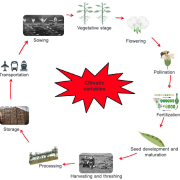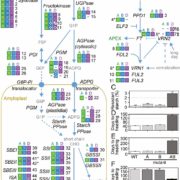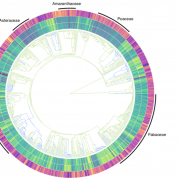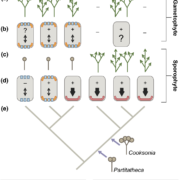Genomics from bean to cup: New insights into the history of Arabica coffee diversification
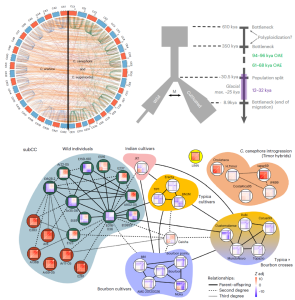 As one of the most traded commodities in the world, coffee has cultural and economic impact that spans continents. The main source of coffee beans, Coffea arabica (Arabica), is a polyploid species that resulted from the hybridization between diploid C. canephora (Robusta) and C. eugenioides (Eugenioides). Here, Salojärvi et al. produce chromosome-level assemblies of all three species, and reveal kinship and population dynamics estimates for 41 wild and cultivated coffee cultivars. No clear dominance expression pattern was observed between the Robusta- and Eugenioides-derived subgenomes of C. arabica. The overall low genetic diversity found in C. arabica, evidenced by its susceptibility to diseases such as leaf rust, is attributed to its relatively recent polyploid origin, estimated at 610-350 thousand years ago (ka). Population parameters point to a long bottleneck event (350-30.5 ka) ending with a more favourable climate for coffee growth and the split between today’s wild and cultivated populations. Migration across the split ended at ca. 9 ka, with wild populations alone facing another bottleneck, while cultivated Arabica spread to Yemen. In fact, Arabica cultivation is documented in Yemen in the 15th and 16th centuries, from where a handful of seeds made it to India; cultivation soon spread across Asian Dutch colonies. Some plants were brought to Europe and then spread by colonizers even more widely, notably from the island of Bourbon (present-day Réunion). Genomic data further documents the history of coffee: early Indian cultivar JK1 and later Typica and Bourbon cultivar groups are estimated to all share close kinship, reinforcing their ultimately Yemeni origin. Through natural hybridization with Robusta, a group of Timor Arabica cultivars are resistant to leaf rust. The Robusta introgression shared by resistant hybrids comprises blocks of candidate resistance genes that will be valuable tools in breeding strategies for leaf rust-resistant Arabica. (Summary by John Vilasboa @vilasjohn) Nat. Genet. 10.1038/s41588-024-01695-w
As one of the most traded commodities in the world, coffee has cultural and economic impact that spans continents. The main source of coffee beans, Coffea arabica (Arabica), is a polyploid species that resulted from the hybridization between diploid C. canephora (Robusta) and C. eugenioides (Eugenioides). Here, Salojärvi et al. produce chromosome-level assemblies of all three species, and reveal kinship and population dynamics estimates for 41 wild and cultivated coffee cultivars. No clear dominance expression pattern was observed between the Robusta- and Eugenioides-derived subgenomes of C. arabica. The overall low genetic diversity found in C. arabica, evidenced by its susceptibility to diseases such as leaf rust, is attributed to its relatively recent polyploid origin, estimated at 610-350 thousand years ago (ka). Population parameters point to a long bottleneck event (350-30.5 ka) ending with a more favourable climate for coffee growth and the split between today’s wild and cultivated populations. Migration across the split ended at ca. 9 ka, with wild populations alone facing another bottleneck, while cultivated Arabica spread to Yemen. In fact, Arabica cultivation is documented in Yemen in the 15th and 16th centuries, from where a handful of seeds made it to India; cultivation soon spread across Asian Dutch colonies. Some plants were brought to Europe and then spread by colonizers even more widely, notably from the island of Bourbon (present-day Réunion). Genomic data further documents the history of coffee: early Indian cultivar JK1 and later Typica and Bourbon cultivar groups are estimated to all share close kinship, reinforcing their ultimately Yemeni origin. Through natural hybridization with Robusta, a group of Timor Arabica cultivars are resistant to leaf rust. The Robusta introgression shared by resistant hybrids comprises blocks of candidate resistance genes that will be valuable tools in breeding strategies for leaf rust-resistant Arabica. (Summary by John Vilasboa @vilasjohn) Nat. Genet. 10.1038/s41588-024-01695-w


